Mary Lou and I try to get out each morning about three-quarters to a half hour before sunrise, when the skies are clear and the air is often cool and still.
With the approach of winter, the period of twilight lengthens as the southward path of the rising sun rolls along just beneath the eastern horizon. On the first day of summer the Sun rises more directly and the sky takes less time to lighten up. This phenomenon is much more apparent nearer the Equator, where the "Dawn comes up like thunder," quickly turning from dark to light.
On November 6 our walk was cut short by the threat of rain. Just before sunrise, the eastern horizon appeard to be on fire ("Red in the morning, sailors take warning"):
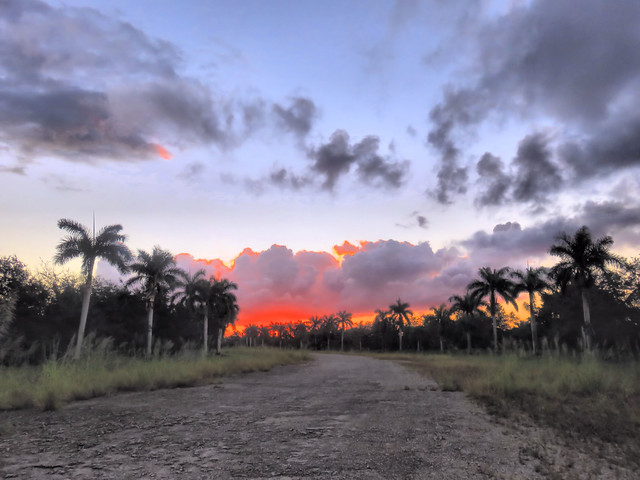
On the way in it is usually too dark for photography, but on another morning I tried anyway as a Tricolored Heron flew past before sunrise...
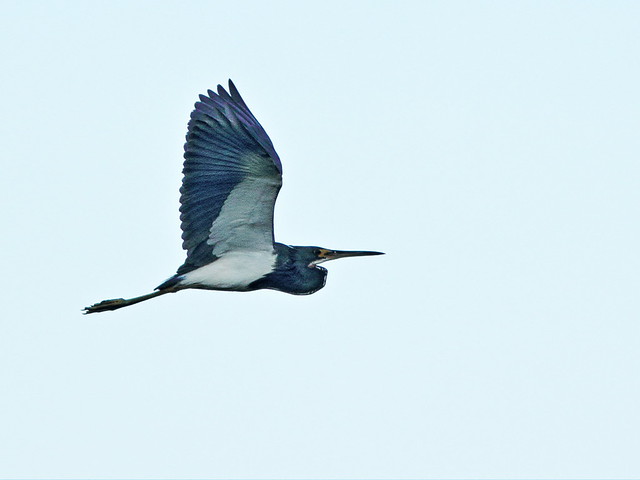
...as did an Osprey:
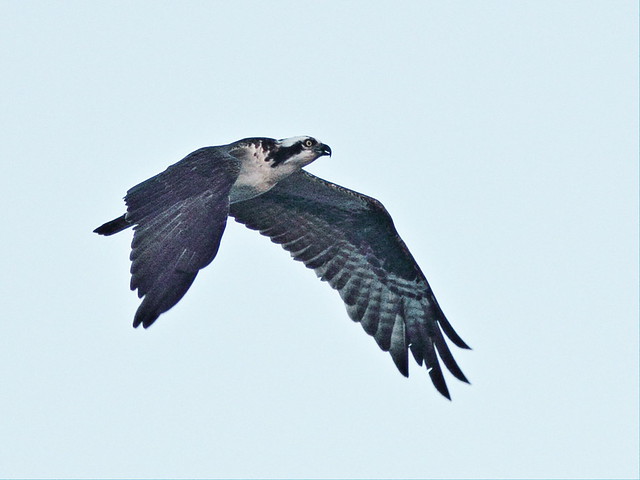
Later in the day, a Loggerhead Shrike stood guard atop a Pond Cypress...
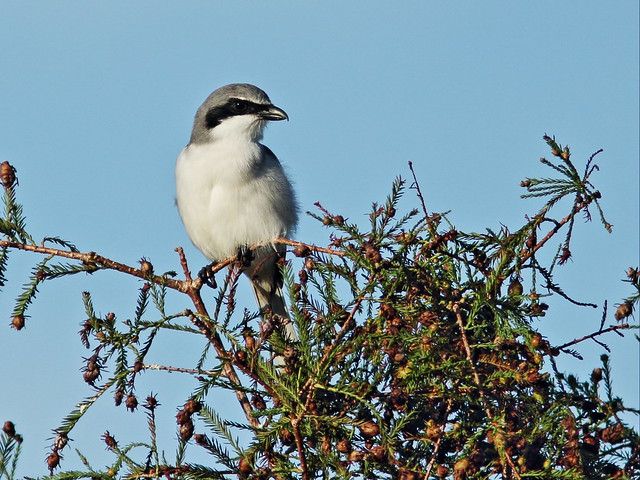
...and an American Kestrel perched on a leaf shoot from a Royal Palm :
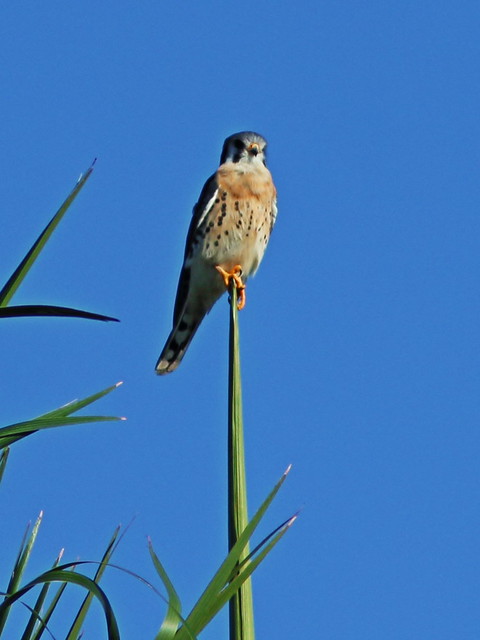
At what remained of the once-thriving heron rookery, the only occupants were a female Yellow-crowned Night-Heron...
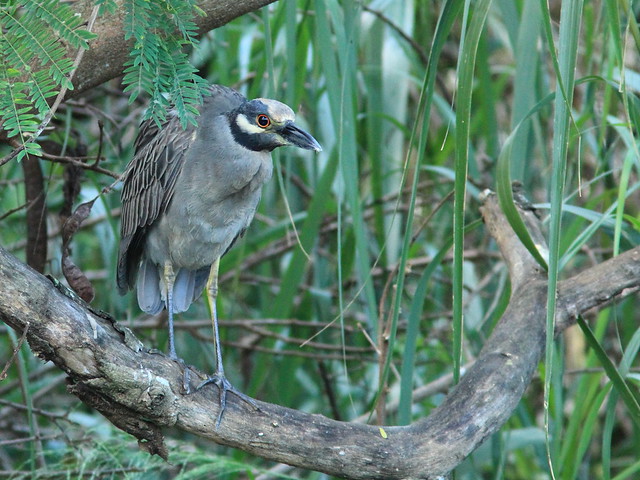
...and a Black-crowned Night-Heron:
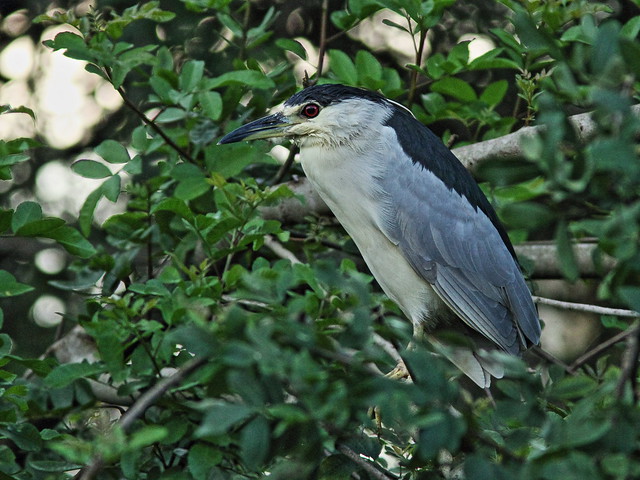
Visitors from the north, two Eastern Phoebes shared the top of another cypress:
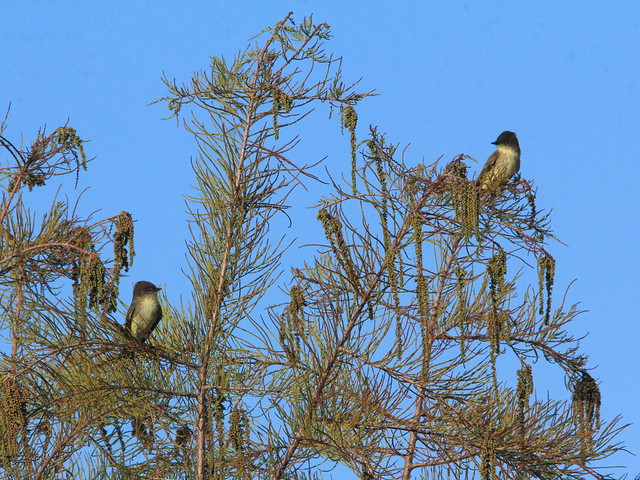
A Gulf Fritillary extracted nectar from a Lantana flower:

The fruits of Lantana attract buntings. A male and female Painted Bunting suddenly flew to a nearby perch:
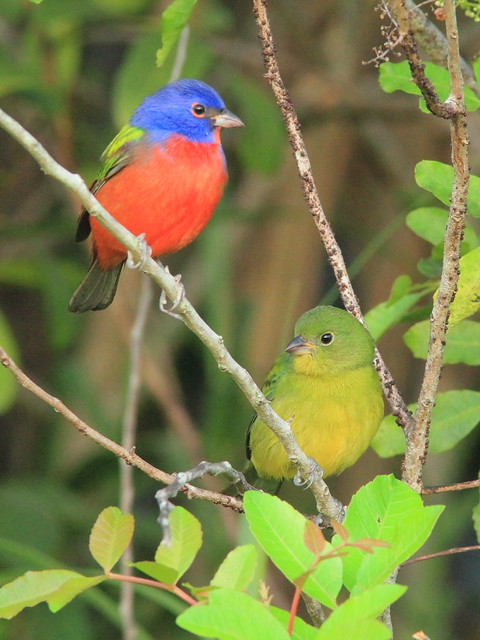
I love to observe and photograph this species away from artificial feeders. The males are usually shy and retiring, so this was a lucky series of shots:
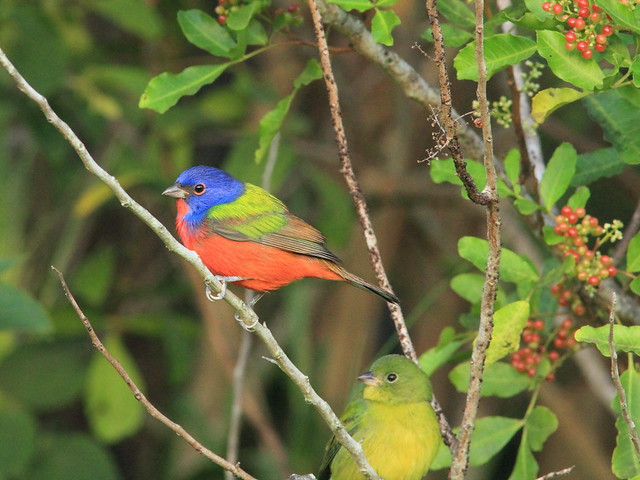

A female Painted Bunting perched on a tall grass stem:
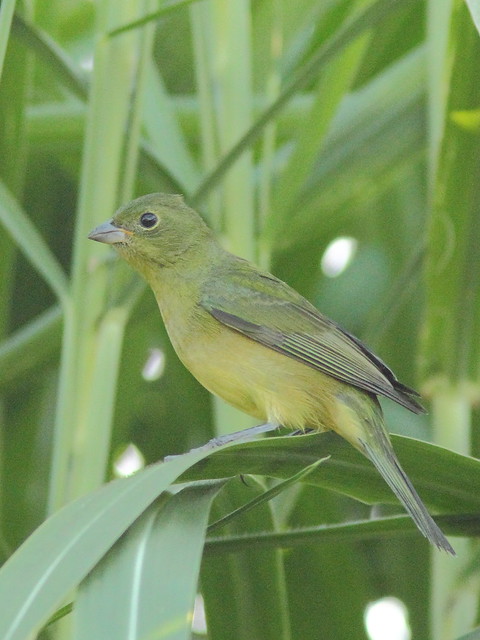
An Ovenbird flew in but did not provide me with a clear view:

A Ruby-throated Hummingbird foraged in a Ligustrum bush. I could not see it in the viewfinder but clicked the shutter blindly several times. It happened to appear in one photo:

Black-throated Green Warblers foraged in the Live Oaks:
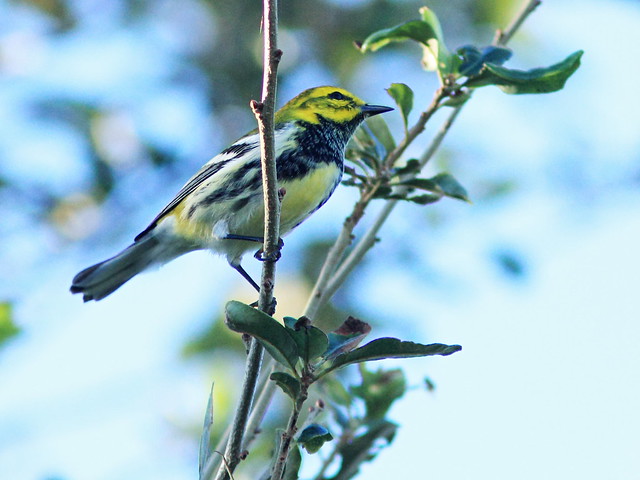
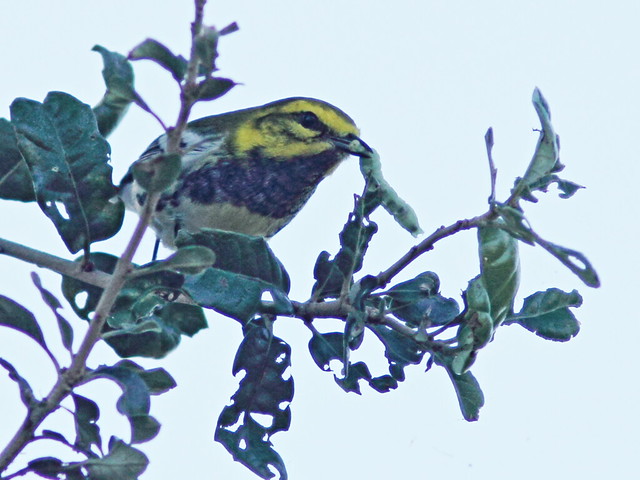
They are very active, flitting among the branches in search of caterpillars:
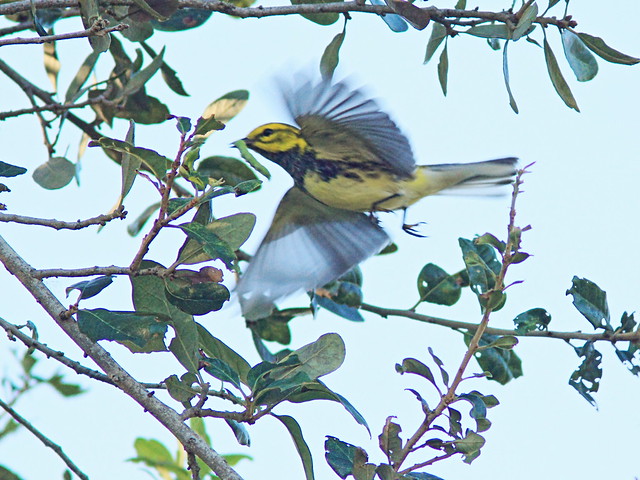
These flowers were tiny, less than 1/2 inch wide. I got this shot with my Canon PowerShot SX700 HS in macro mode, hand held. Image stabilization is amazing. It is just a "weed" (Largeflower Mexican Clover -- Richardia grandiflora), but close up it looks like a magnificent bouquet.
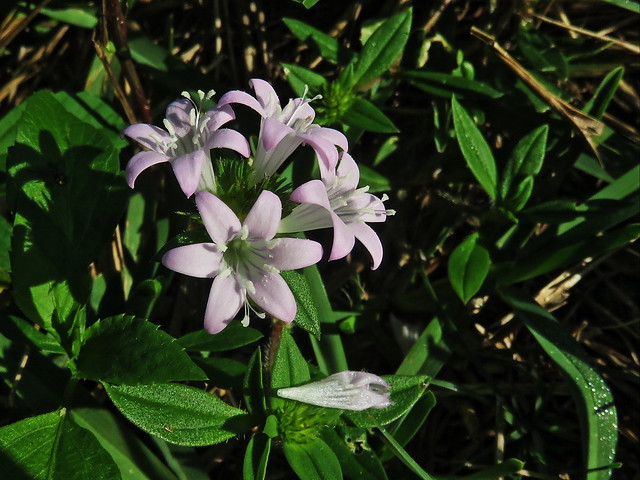
On November 9 the clouds moved in a bit later in the morning:
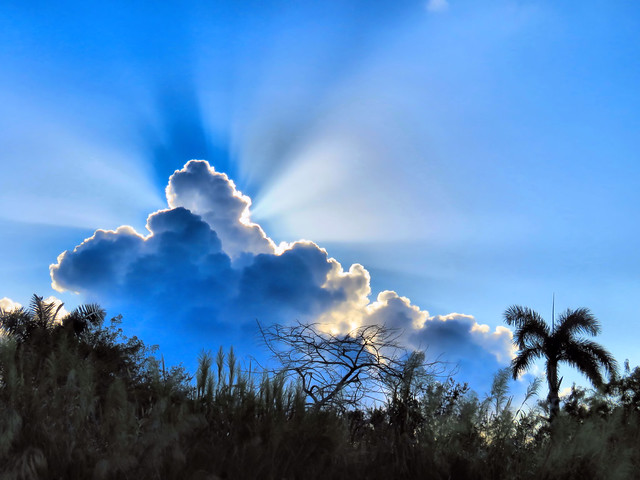
We kept a wary eye on the storm as we walked back towards home:
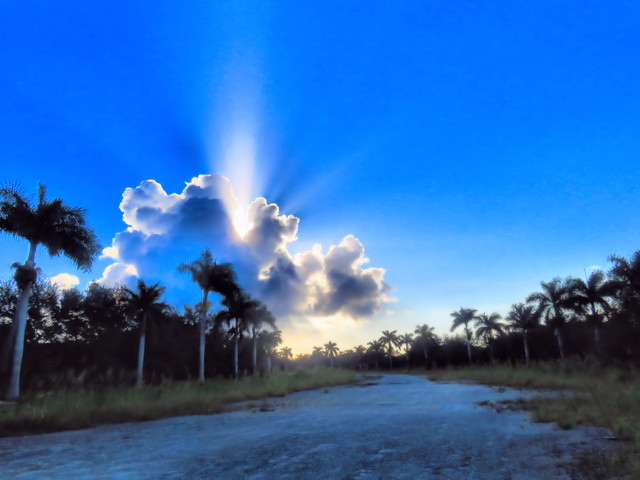
At the gate, the Ixora blossoms attracted butterflies:

Among them, a tiny Tropical Checkered-skipper with a wingspan of less than an inch:
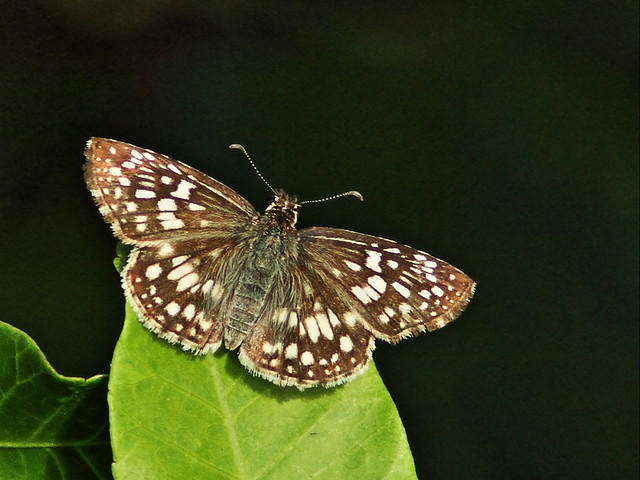 Fog lifting on opposite shore:
Fog lifting on opposite shore:
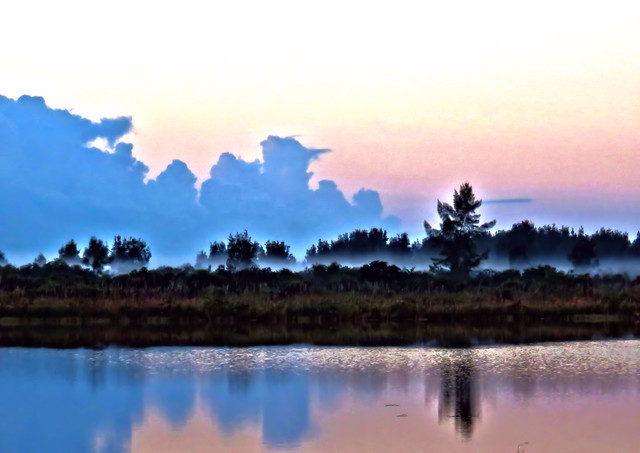 = = = = = = = = = = = = = = =
= = = = = = = = = = = = = = =
Linking to Misty's CAMERA CRITTERS,
Linking to Eileen's SATURDAY'S CRITTERS,
Linking to GOOD FENCES by Tex (Theresa).
Linking to SKYWATCH FRIDAY by Yogi, Sylvia and Sandy
Linking to WEEKEND REFLECTIONS by James
Linking to BirdD'Pot by Anni
Linking to Wild Bird Wednesday by Stewart
Linking to I Heart Macro by Laura
________________________________________________
Please visit the links to all these memes to see some excellent photos on display
________________________________________________
To an outsider, our daily walks out into the wounded wetlands near our home must appear rather routine and uninteresting. What more can be seen after the first few times walking into that mosquito-infested place?
A Great Blue Heron is visible through the lakeside reeds:
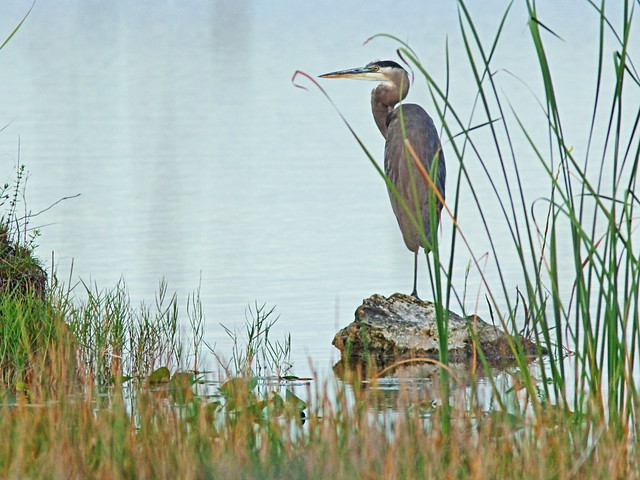
Buttermilk clouds crowd the sky:
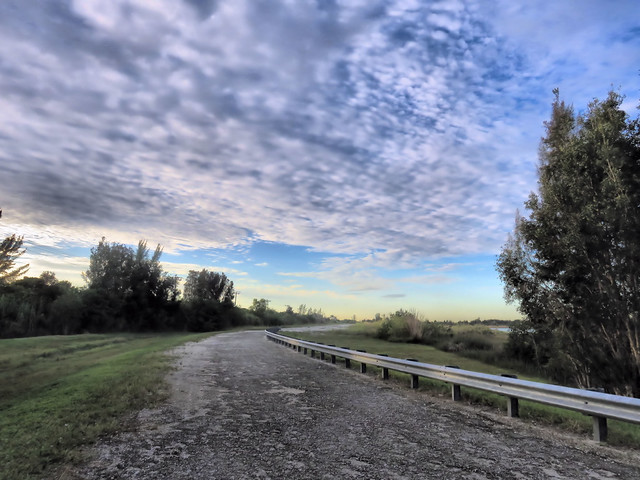
The lake overflows into the prairie:
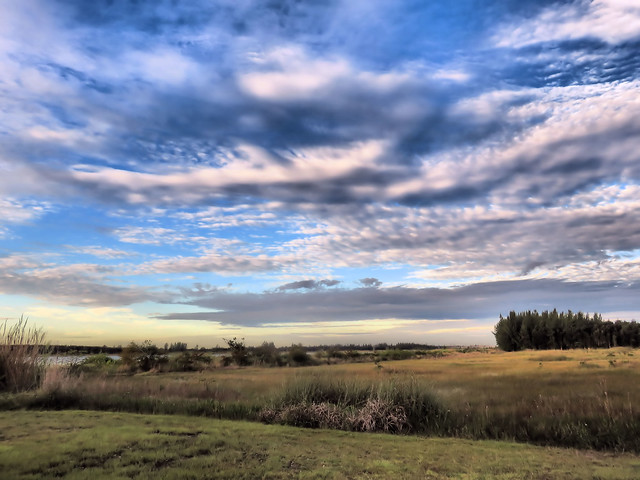
In truth, depending upon the season, we see a predictable group of birds. Many are probably the same individuals who watch us in turn. Yet we greet each day with anticipation-- not simply to see a new bird or beast or bug, but to feel the joy of being outside and open to new discoveries. We greet the changes of season which bring with them new bird species, but day to day can also bring surprises. It's not just about birds or the occasional wild mammal we encounter. For example, over the past eleven years I have seen a particular butterfly species only three times out in our patch.
A Giant Swallowtail suddenly reappeared on the first day of November. Wings never stopped beating, it visited the Lantana flowers so briefly that I could barely keep it in the viewfinder of my camera. It stayed in one place for no longer than a second or two, wings constantly aflutter as it swiftly thrust its proboscis into the calyx of each flower. I chased it for about 10 minutes before it decided to spend a bit more time on a particular plant that was rich with blossoms:
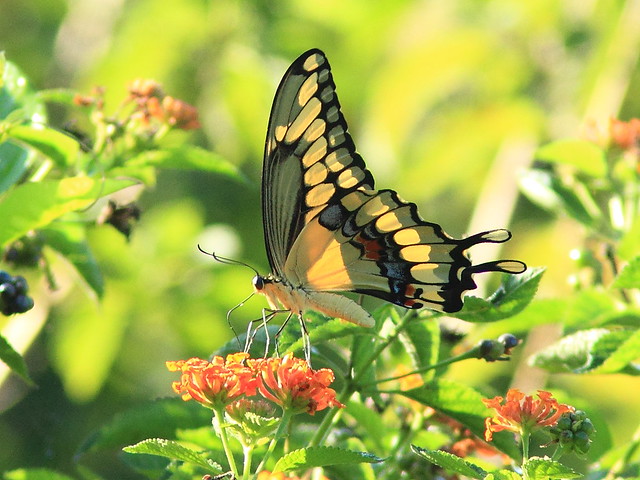
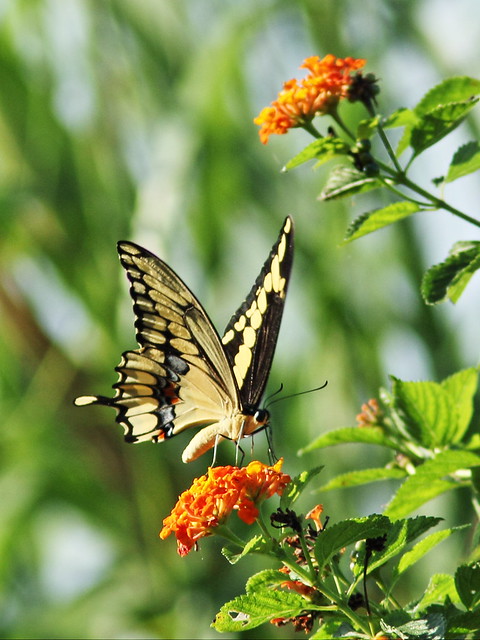
Common subjects provide sudden unexpected flashes of beauty, such as the gilded flight feathers of this Northern Flicker...
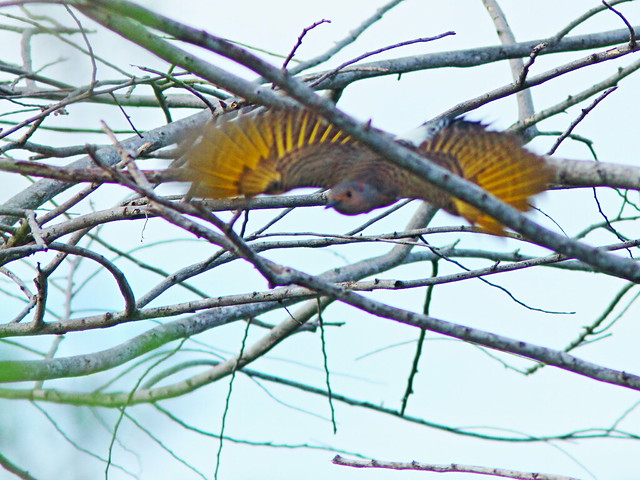
...a Blue Jay enjoying a bounty of acorns...
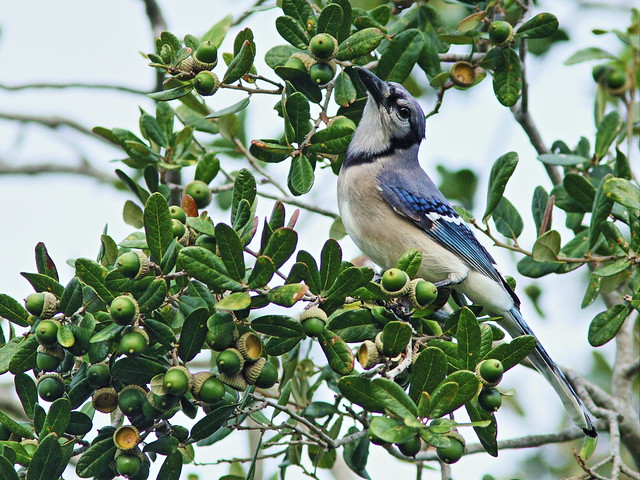
...a Gray Squirrel sharing the feast...
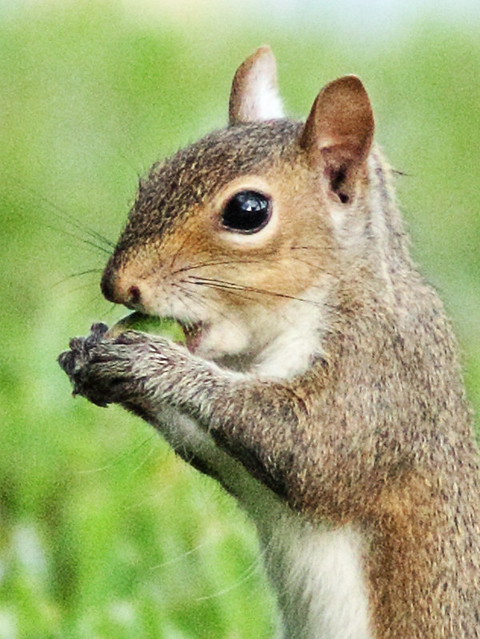
...the uneasy thrill of discovering that a Bobcat is watching me silently from only 30 yards...
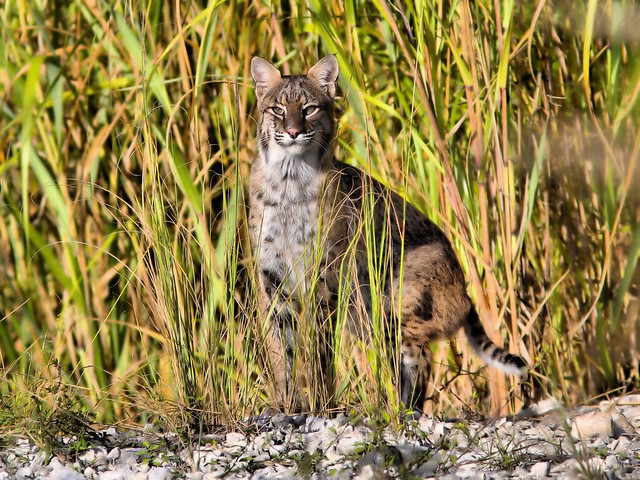
...the placid beauty of a White-winged Dove bathed in shade...

...the unusual arrival of a Philadelphia Vireo, the first I have ever seen on this patch (October 18, 2015):
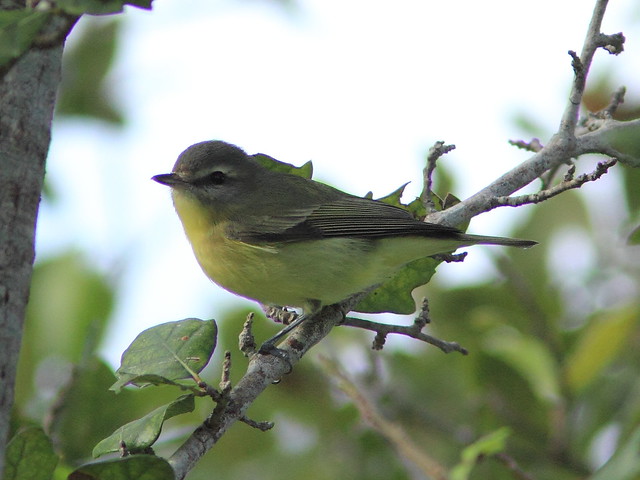
Remarkably, I have seen and photographed a Bell's Vireo during three fall seasons, in October of 2009 and 2012, and again this October, 2015. Breeding in Central USA, it normally migrates to Mexico via west Texas and rarely wanders into Florida, where it has been reported in Florida an average of only once every fall. It lingered here over a two week period in late October--
October 15, 2015:
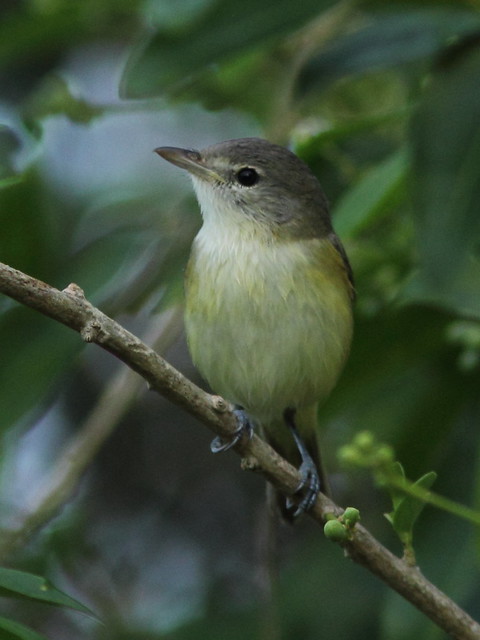
October 31, 2015 (check out those bright blue legs!):
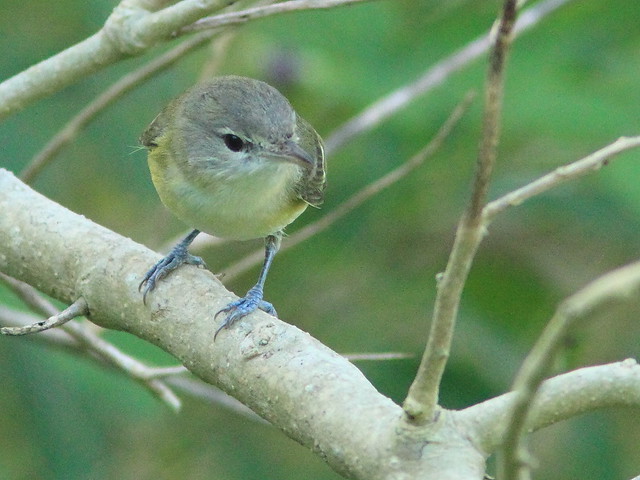
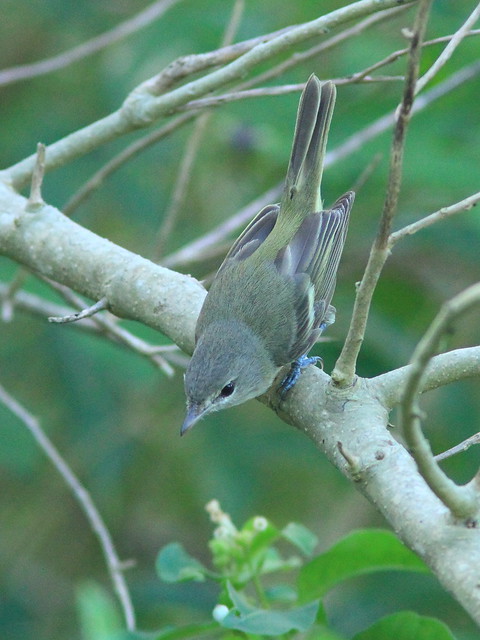
No, it is not only about birds. A fish sends ripples over the lake in the still of morning, breaking up the sky's reflection:

A Long-tailed Skipper rests on a leaf:
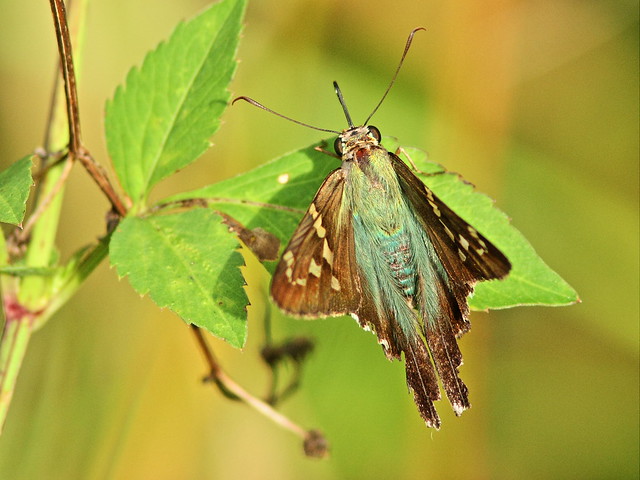
= = = = = = = = = = = = = = =
Linking to Misty's CAMERA CRITTERS,
Linking to Eileen's SATURDAY'S CRITTERS,
Linking to GOOD FENCES by Tex (Theresa).
Linking to SKYWATCH FRIDAY by Yogi, Sylvia and Sandy
Linking to WEEKEND REFLECTIONS by James
Linking to BirdD'Pot by Anni
Linking to Wild Bird Wednesday by Stewart
Linking to I Heart Macro by Laura
________________________________________________
Please visit the links to all these memes to see some excellent photos on display
________________________________________________
Water levels strongly influence the number and species of wading birds that we see on the lake in our local wetlands. Florida's breeding birds have evolved life cycles that adapt to seasonal changes in the availability of food, which in turn is tied to water levels in the historic Everglades.
An anvil head looms over the Everglades, August 17, 2015:
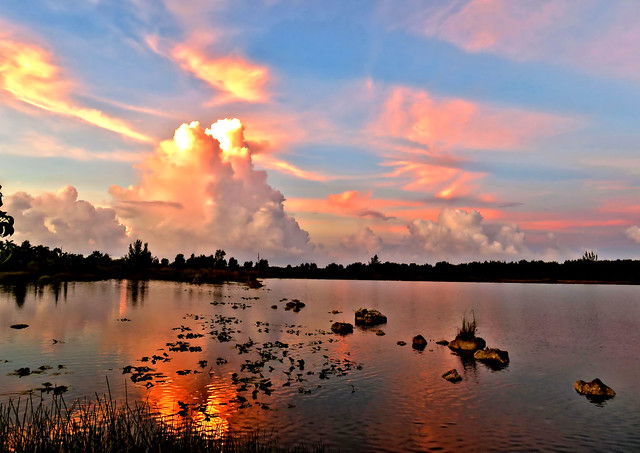
Our local wetlands are not directly connected to the adjacent Everglades preserve and are fed by seepage of ground water and storm water from local rainfall. Yet their cycle of water levels roughly parallels that of the Everglades. This year the wet season has persisted into early November, in what the weather forecasters call a "spring pattern" of almost daily rain showers and thunderstorms. An old cypress stump in the lake which I call the "Enchanted Island" serves as a convenient water gauge.
A Red-winged Blackbird casts a reflection as it perches on the "Enchanted Island," March 1, 2015:
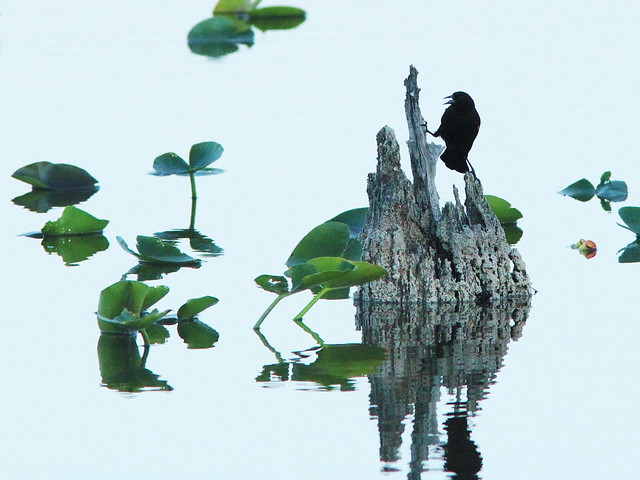
Water levels fell and rainfall was sparse into early summer. Only half the normal amount of rain fell from January through June. The Enchanted Island stump was landlocked, July 24, 2015:
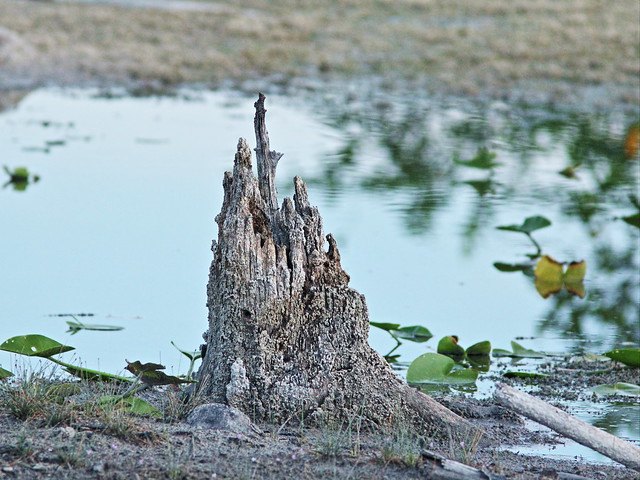
As the lake receded it left isolated pools along the shoreline, trapping fish, to the delight of the herons (July 27, 2015):
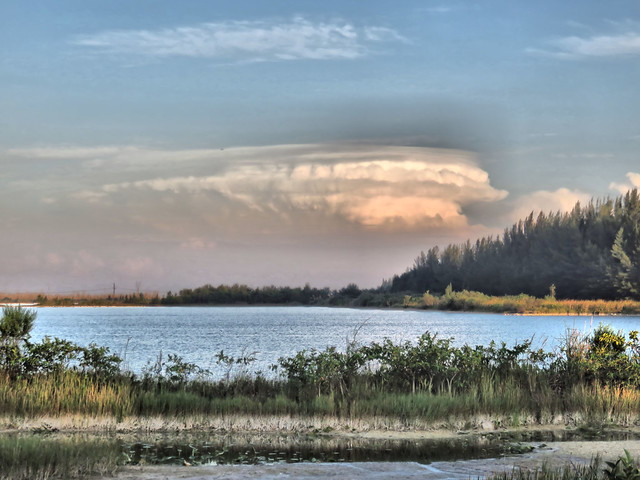
Heavy rains beginning in mid-summer brought the lake to its highest level. On October 26, 2015 only the tip of "Enchanted Island is visible.
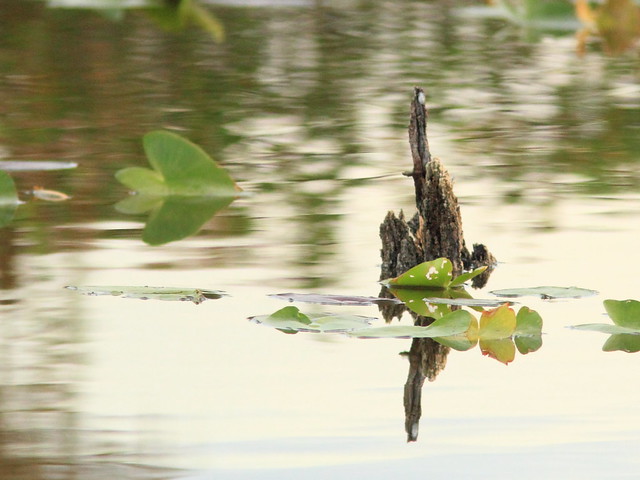
The summer wet season normally peaks in August and September, often bringing floods, especially when the normal rainfall is augmented by hurricanes and tropical storm systems. While average annual rainfall is about 52 inches (133 cm) , summer rainfall averages 34-35 inches (88 cm) and has varied greatly from 23.4 to 53.5 inches (59-136 cm) in years between between 1918 and 1985. The dry season (which peaks between December and February) averaged 17-18 inches (44 cm) with annual extremes between 7.3 and 30.9 inches (19-78 cm).
During the winter (dry) season in Florida the crescent moon is illuminated from the bottom, giving it a "U" shape. Legend has it that the cup-shaped moon is trapping the rain water and preventing it from reaching the ground (November 5, 2015):
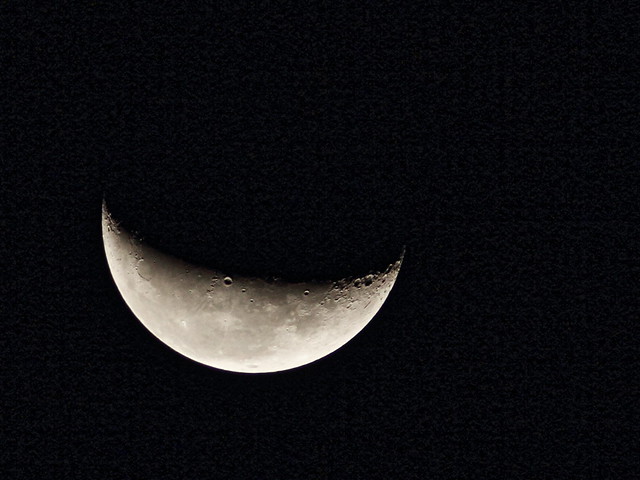
Two general groups of long-legged waders are affected somewhat differently by the changes in water levels: the herons and egrets, which hunt by sight, and the ibises and storks, which are tactile feeders.
Normally, with the approach of the dry season, water levels diminish. If there has been a bountiful wet season, prey items then become concentrated, which is good for both groups of waders. Tactile feeders especially benefit from relatively shallow water as prey must wander into their waiting jaws. However, with drought the wet prairies may dry up completely, confining the water to creeks or channels (sloughs or "slews") where sight feeders have a competitive advantage. Drainage and development of vast portions of the Everglades have reduced the amount of prairie land and channeled the water into deep ditches and canals, further reducing the foraging areas of tactile feeders.
The best time for all of these birds to breed is around November, just as prey is becoming easier to find and standing water helps protect their nesting colonies from terrestrial predators. Ideally, the water will still be low and prey plentiful when nestlings have their greatest need for food.
Herons have forward-facing binocular vision, as demonstrated by this displaying Yellow-crowned Night-Heron:
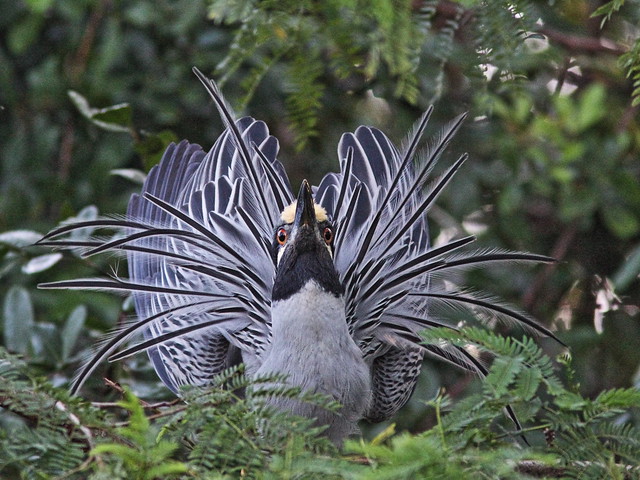
Herons, like this Snowy Egret, are also able to compensate for the shifting of the image of a fish caused by refraction at the surface of the water:
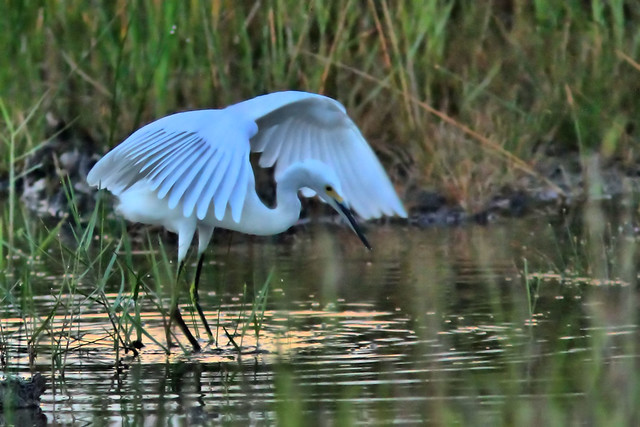
Water that is about 7-9 inches deep is ideal for this tactile feeder, as it allows the Wood Stork to keep its eyes above the surface to watch for predators as it feeds:

The White Ibis is an adaptable tactile feeder, probing for crustaceans in the mud and even for lizards, worms and other insects in grass turf:
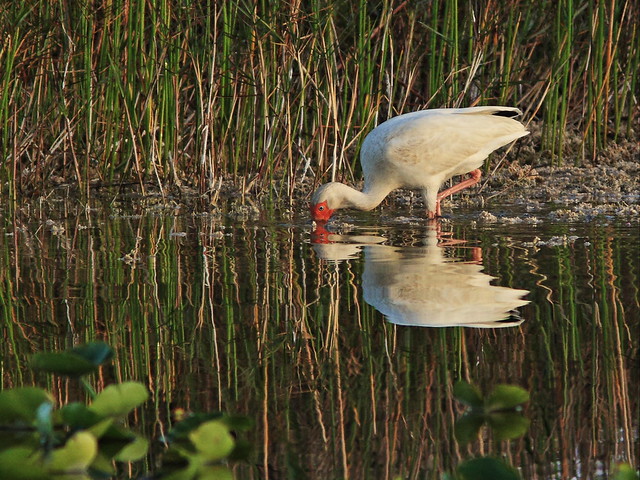
The Whooping Crane (a captive-bred wandering migrant from Wisconsin) captures prey by sight:
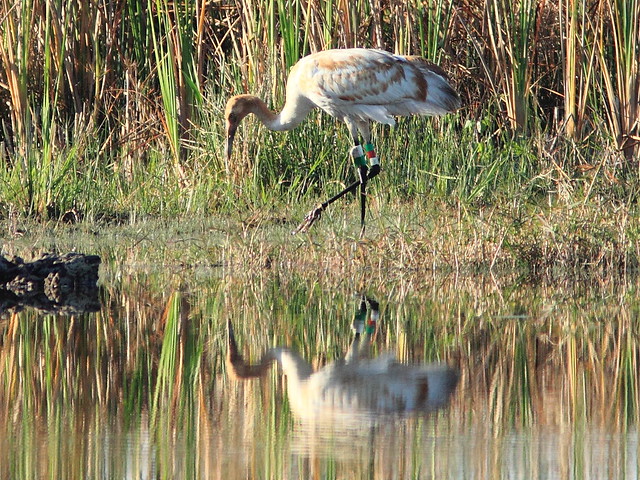
Ibises generally forage near their nests and may move their breeding colonies to take advantage of local conditions. Wood Storks forage more widely and tend to use permanent colonies. They may delay breeding until water levels fall to an acceptable level, sometimes into February or March. This introduces the danger that offspring may starve if the wet season begins early. In many years the storks may not breed at all (as has happened because of the erratic weather over the past several years), or the parents may need to fly so far to find food that their chicks are left unguarded or starve.
Only ten years ago, Wood Stork colonies in south Florida included hundreds and even thousands of individuals. Sadly, Wood Storks have now abandoned their historic breeding grounds because of the combination of the effects of a changing climate and human disturbance of their habitat. They now populate new colonies to the north, in Louisiana and up to North Carolina. Families of storks commonly visited our lake in late winter or early spring, following breeding season. I have seen none on our lake since February 2, 2015.
Six Wood Storks, representing two families, each with a single offspring, made a memorable visit to our back yard lake on January 23, 2012 and perched on a fence on the oopposite shore. The immature bird in this family portrait is the one on the left. Note its pale bill and legs and that unlike its parents, its head is not yet bald:
 A Macro view of an adult stork:
A Macro view of an adult stork:
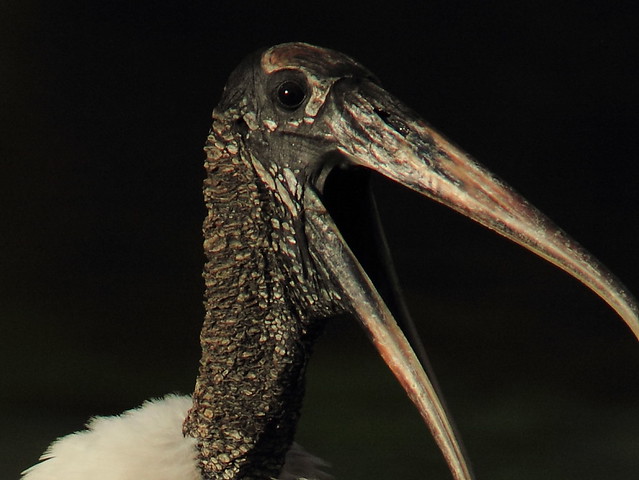 = = = = = = = = = = = = = = =
= = = = = = = = = = = = = = =
Linking to Misty's CAMERA CRITTERS,
Linking to Eileen's SATURDAY'S CRITTERS,
Linking to GOOD FENCES by Tex (Theresa).
Linking to SKYWATCH FRIDAY by Yogi, Sylvia and Sandy
Linking to WEEKEND REFLECTIONS by James
Linking to BirdD'Pot by Anni
Linking to Wild Bird Wednesday by Stewart
Linking to I Heart Macro by Laura
________________________________________________
Please visit the links to all these memes to see some excellent photos on display
________________________________________________




















































